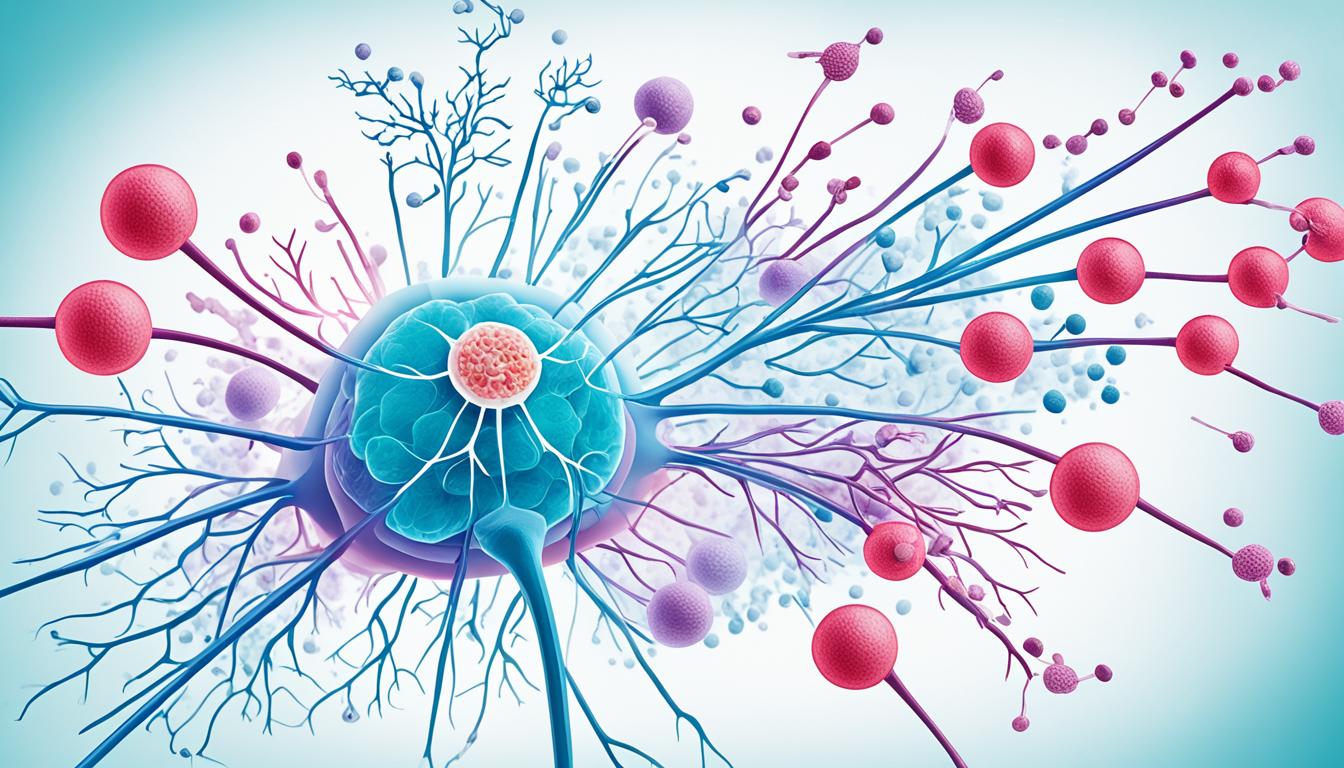IgA nephropathy, known as Berger’s disease, affects the kidneys. It’s marked by IgA antibodies collecting in the kidneys. This can cause kidney inflammation and damage.
Its exact cause is still uncertain. Yet, it’s thought to be linked to overproduction of IgA antibodies. Both environmental factors and genetics might also influence its development.
To diagnose IgA nephropathy, doctors often do a kidney biopsy. This helps see if IgA deposits are present. Blood tests and imaging are used to check kidney health.
There are various treatment options for IgA nephropathy. These aim to slow the disease, ease symptoms, and protect the kidneys. Medications for blood pressure and inflammation control are common. Stem cell therapy is a new and promising treatment for this condition.
Key Takeaways:
- IgA nephropathy, also known as Berger’s disease, is an autoimmune kidney disorder characterized by immunoglobulin A (IgA) deposits in the kidneys.
- Symptoms of IgA nephropathy can include hematuria, proteinuria, and decreased renal function.
- The exact cause of IgA nephropathy is still unknown, but abnormalities in the production of IgA antibodies, genetic factors, and environmental triggers may contribute to its development.
- Diagnosis involves a kidney biopsy to inspect IgA deposits. Other tests check kidney function.
- Treatment options for IgA nephropathy include medications to control blood pressure, reduce inflammation, and new approaches such as stem cell therapy.
Causes and Symptoms of IgA Nephropathy
IgA nephropathy, known as Berger’s disease, affects the kidneys. It is linked with an antibody known as immunoglobulin A (IgA) located in the kidneys. While the direct cause remains unknown, studies point to genetic factors and abnormal production of IgA antibodies. Infections and certain triggers from the environment might also play a part.
The signs of IgA nephropathy differ but often include hematuria (blood in the urine), proteinuria (too much protein in the urine), flank pain, and swelling in the hands and feet. Sometimes, these signs can be mild. A rise in high blood pressure might also occur. It’s essential that anyone with these signs sees a nephrologist for further tests.
This disease attacks the kidneys, causing inflammation and damage. If the inflammation damages the blood vessels, it leads to blood in the urine. Meanwhile, kidney damage allows protein to leak into the urine, causing proteinuria. Flank pain, and hand and foot swelling signal kidney dysfunction. Kidney trouble can also raise blood pressure.
To diagnose IgA nephropathy, a detailed check-up is necessary, usually including a kidney biopsy. This test is crucial in confirming IgA deposits in the kidneys. Blood tests and scans are also done to check kidney function and exclude other issues.
Next, we will dive into the diagnosis and treatment of IgA nephropathy in Section 3.
Diagnosis and Treatment Options for IgA Nephropathy
Diagnosing IgA nephropathy involves a thorough look for IgA deposits in the kidneys. The best way to do this is with a kidney biopsy. In this test, a small piece of kidney tissue is taken for examination. This test is key for a proper diagnosis. Blood tests are also done to check how well the kidneys are working and to rule out other kidney problems.
After diagnosis, patients and their doctors create a treatment plan. The aim of this plan is to slow down the disease. It also helps to manage the symptoms and keep the kidneys working as best as they can. The treatment can change based on how bad the disease is and the patient’s own health.
Doctors often start by managing blood pressure. Keeping blood pressure under control is crucial. High blood pressure can make kidney problems worse. Medicines like ACE inhibitors and ARBs help lower blood pressure. This cuts the risk of more kidney damage.
Controlling inflammation in the kidneys is also key. NSAIDs can help with inflammation. They can also lessen the amount of protein that leaks into the urine. For more serious inflammation, doctors might suggest immunosuppressants or steroids. These help calm down the immune system, which stops it from attacking the kidneys.
Thanks to new research, treatments for IgA nephropathy are evolving. Stem cell therapy is one such new approach. It’s designed to build up kidney function. Healthy stem cells are put into the body. They aim to fix and improve kidney health.
People with IgA nephropathy must stay in close touch with their doctors. They need regular check-ups and open discussions about their care. This helps ensure the disease is well managed. It also helps keep the kidneys as healthy as possible.
Conclusion
IgA nephropathy is a tricky kidney disease that can harm the kidneys slowly over time if not treated early. Quick diagnosis and action can help a lot. This keeps kidney damage minimal and function well. Daily medications and new therapies like stem cell therapy are part of the treatment plan.
Stem cell therapy is especially exciting. It’s been successful in boosting kidney function. This means fewer patients may need serious options like dialysis or a kidney transplant. While we need more study, stem cell therapy brings hope to those with IgA nephropathy.
Thanks to better technology and frequent studies, the outlook for IgA nephropathy is improving. Options for care are expanding, and patients can get treatments customized for them. Working closely with a healthcare team is key. Together, they can find the best plan for each patient.

